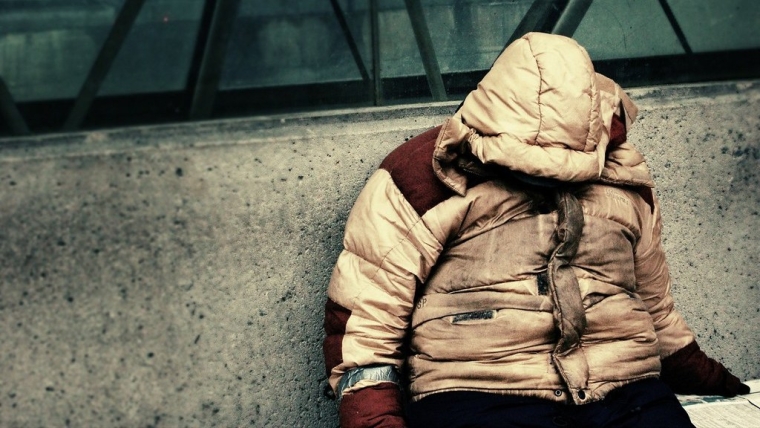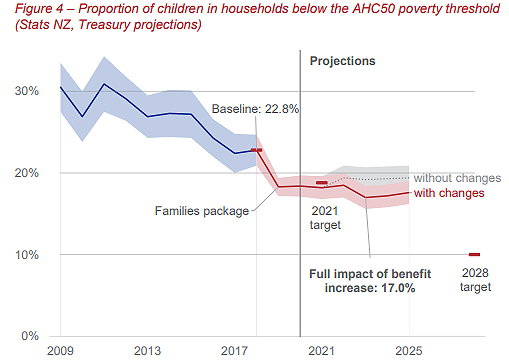
This is a re-post of an article originally published on pundit.co.nz. It is here with permission.
Child poverty levels are only slowly coming down; what next?
Having settled on its macroeconomic settings, the Government then has to decide what to do with its revenue. In the 2021 Budget; it was largely committed to rolling forward existing spending, together with meeting some necessary commitments like dealing with covid and upgrading the pay of some nurses and teachers. Deciding not to give any tax cuts, the new spending initiatives reported are Table 10 of the Wellbeing Budget 2021. (Covid spending is reported separately.)
Contingencies aside, the proposed initiatives totalled $3.3b this year. Leaving education and health spending out – they include allowances for those payrate increases and for population change and inflation – the total came to $1.9b, an amount that would have been fiercely fought over among the cabinet ministers.
And yes, as the Minister of Finance announced, the biggest share – over a third – went to the war on child poverty. Add new housing spending and almost a half of the new initiatives was spent on income and wealth redistribution.
The minister proudly announced that
... the Government’s actions to date have reduced child poverty rates, using the after-housing cost measure, to the extent that there are 43,000 fewer children in low-income households and 18,000 fewer children experiencing material hardship. This is one of the largest policy driven falls in measured child poverty in decades. But equally, we know there is more to do to meet all the clear targets laid out.
While not devaluing the effort, the kicker is in the last sentence. It might have been better to have said ‘there is much more to do’. You can see this in the graph (below) from page 31 of the Wellbeing Report. The poverty rate drops from 18.5 percent of children in June 2022 to 17.0 percent to June 2023. (Note that there is no further expected reductions from the measures after 2023. In fact Treasury expects a slight rise – I am not sure why.)
The Government target rate is 10 percent in June 2028. Simple arithmetic says that if it cost around $600m to reduce the poverty rate 1.5 percentage points to get it to 17 percent, then the additional cost to get the rate to 10 percent is about $2.8 billion, or around another $600m in each of the next five years – about a third of the funds available for new initiatives.
I should warn you that the arithmetic assumes that the household income distribution is linear near the current situation. It usually it is, but for a range as large as those involving the targets the assumption may not be near enough. Moreover, other measures such as those involving housing, may accelerate the decline. (There are also various tricks outside the spirit of the target intention to reduce the rate more cheaply. I wont list them because while I accept this government is honest, others may not be.)
I am not arguing that the 2021 package needs to be replicated in each of the next five budgets. The government increased benefits by up to $55 per week for relevant adults. You might conclude that it needs a further benefit hike of, say, $250 a week to attain the target. But child poverty is not just among beneficiaries. They include workers, some of whom are on above average wages coupled with a number of children and expensive housing.
Thus there is some urgency in improving the work-benefit interface. Working-for-Families was a botch job. For over a decade governments have promised to fix it, but haven’t. The most likely reason is that they have had not the technical capacity. They seem to have been relying on those who may have warm hearts towards the poor but do not have the modelling competence. My greatest pleasure from the budget is that, as indicated by the graph above, Treasury is building a projection model of poverty, which means they are evolving that capacity. About time.
We probably also need to work on the housing-to-benefit interface. There will be outcries in July, when adult beneficiaries were told they would be getting an extra $20 a week. Those in state housing will get only $15, because a quarter will be used to reduce their rent subsidies.
As well as getting the interfaces better and paying more attention to working families, we need to think about large families. The government strategy has tended to increase the income of adults independent of the number of children they have. The effect is to leave large families in more permanent poverty. While the government claims it had restored benefits to the real level of Richardson-Shipley cuts thirty years ago, the fact is slightly different. The universal family benefit was also cut but it has not been reinstated. My guess is that its replacement needs to be taxable so it is more valuable in absolute terms to those on low incomes (and much more valuable in relative terms.).
Note also that, as the Wellbeing Report observes (on page 2), those not-in-the-labour force because of sickness, injury or disability have markedly less satisfaction in life. It is not clear to what extent the government is addressing this.
In summary, the 2021 budget was work-in-progress in the war on poverty. Much more is required. It was common to say that the benefit increases were insufficient. The graph demonstrates that but, on the other hand, the boosts were not trivial. As the Treasury forecasts show, they are a down payment for progressing towards the government’s child poverty targets. The best news is that we are on our way, and that Treasury is building up the capacity to guide us there.

Brian Easton, an independent scholar, is an economist, social statistician, public policy analyst and historian. He was the Listener economic columnist from 1978 to 2014. This is a re-post of an article originally published on pundit.co.nz. It is here with permission.
9 Comments
The issue we face is that poverty and cost of housing are likely codependent. The more money we yeet at poverty the less impact it will have because the housing market isn't easing at all. A few small changes to zoning, RMA and tax could probably do a lot more than a $2.8bn indirect subsidy to landlords.
I know there are many poor people in NZ but I'm not so sure there is as much poverty as MSM and some not so MSM make it out to be. My comparison is parts of India , Africa, and South American countries to name a few obvious ones have real poverty.
Ah yes, here come all the people trying to shift the goal posts and say that because we don't have people literally starving to death, we don't have poverty in this country.
Wake up call - this is a modern, advanced country. We should be aspiring for a better standard of living for all of our population, instead of saying "well the very poorest aren't starving to death yet, so clearly we're doing well".
"Modern, advanced country." Nope, that would be Switzerland, Scandinavia, Germany, Austria.
NZ is an expensive, low wage environment where the standard of living has continually slipped. Poverty (however you define it), is largely borne by Maori and Pasifica. A better question would be why do these groups continually feature in these stats and then addressing the issue rather than just throwing money at it. Nothing will change, and it will only get worse. Greater splits between have vs have nots, disappearing middle class. Racial tension....Fckng shambles
It's right there for everyone too see but nobody wants to acknowledge it. People who are literally homeless in NZ spend their benefit money on tobacco. Go to south Auckland and look around. I dont know about Switzerland, Scandinavia, and Austria but I'd guess they're not too dissimilar from Germany where tobacco is 1/10 the cost that it is in NZ. What do you expect will happen when you raise billions of dollars in tax revenue from the poorest sector of society?
Wealth is access to energy and resources.
Poverty is lack of access to energy and resources
Either you reduce the number of people wishing to access, or you spread the accessing around more equitably.
And you're doing either/both in the face of inexorable depletion.
Why are we still getting articles like this?
Rob Rattenbury in the Whanganui chronicle HERE identifies that NZs rate of homelessness is the worst in the OECD. At what point can we expect our Government to take some real action? Their active and tacit support of landlords is shameful. This has been going on across successive Governments for a while now.
Ka pai Brian. We live in a high income economy, where all the income is (basically) derived from the natural and human resources of the country... Thus poverty is clearly a problem of distribution. Why are the all NZ dollars accumulating in the pockets of the few - is it because of their incredible genius?
A bunch of ideologues in the 1980s and 90s forgot their history lessons and thought all that money would somehow "trickle down", despite it not doing so in the nineteenth century and failing to in the 1920s. I lived in the UK and US during the 80s and remember Tip O'Neill, the old New Deal Democrat calling Reagan "Herbert Hoover with a smile", as he watched the programs he'd fought all his life for, that created a strong middle class, being dismembered. Then I came home and discovered that Roger Douglas was doing the same thing, but far more zealously. A shambles and completely avoidable.

We welcome your comments below. If you are not already registered, please register to comment.
Remember we welcome robust, respectful and insightful debate. We don't welcome abusive or defamatory comments and will de-register those repeatedly making such comments. Our current comment policy is here.